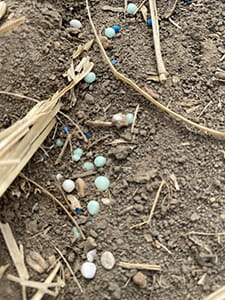By Rebecca Hort, BSc, AAg, Intern Extension Agrologist, Yorkton and Mackenzie Hladun, MSc, AAg, Crops Extension Specialist, Moose Jaw
March 2024
Properly fertilizing your crop is essential to reaching your yield targets. There are several ways to incorporate fertilizer into the soil. The most common ways include applying a band in the fall once the soil has cooled, in the spring prior to seeding or in the mid-row or seed row during seeding. It is beneficial to seed-place immobile nutrients, such as phosphorus and potassium; however, keep in mind the recommended safe rates for seed placed fertilizer. These recommendations are based on seedbed utilization (SBU), soil texture, crop type, soil moisture and the source of fertilizer. Seed bed utilization is the amount of the seedbed that the fertilizer has been spread. A higher SBU means more fertilizer can be seed-placed safely and a lower SBU means less fertilizer can be seed-placed.
The calculation for SBU is:
SBU (%) = (opener spread/row spacing) x 100
Nitrogen is important for plant growth, reaching yield potential and increasing the grain protein content. Nitrogen is mobile in the soil and can be placed in a mid-row band while seeding. This is beneficial because too much nitrogen in the seed row can damage the seed and cause germination problems. Factor in nitrogen from all sources of seed placed fertilizer when calculating safe rates (i.e. applying ammonium sulphate with seed) to ensure your application stays within the safe rates.
Phosphorous and potassium are needed for cell development and signalling and are crucial to plant growth. Both are immobile and do not move in the soil. Putting phosphorous and potassium with the seed is the best way to ensure the crop will get what it needs. Safe seed rates for phosphorous should also be followed to ensure germination. If potassium is seed placed, the pounds of phosphorus plus the pounds of potassium should not exceed the maximum total seed-placed phosphorus.

Some regions of Saskatchewan entered the winter with little soil moisture in the seedbed and many are experiencing dry conditions. Agriculture and Agri-Food Canada publishes drought maps that can help you in evaluating the amount of moisture in your seedbed. If there is low moisture available to your crops during seeding, or if the weather is conducive to seedbed drying, reducing the amount of seed-placed fertilizer by a minimum of 50 per cent is recommended.
Soil testing is important this year, particularly if you had dry conditions in 2023. There could be additional residual nitrogen or other nutrients, left in your field from the previous crop. Soil testing will help account for excess residual nitrogen and reduce the total nitrogen that needs to be applied. If fertilizer needs still exceed the recommended maximum fertilizer rate in the seed row, consider applying the rest in the mid row or through alternative applications prior to seeding. When planning your crop’s fertilizer applications, be sure to follow 4Rs; right rate, time, product and source. 4R designated agronomists can help you to ensure you are fertilizing your crop according to the 4R principles.
Learn more about the safe-rates of seed-placed fertilizer for different crops and SBU, visit Fertilizer Canada, contact your local crops extension specialists or call the Agriculture Knowledge Centre at 1-866-457-2377.
